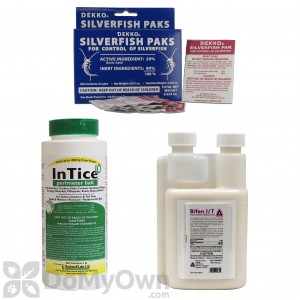Step 1) Perimeter Treatements with Pesticides
The most effective chemical control method for Firebrat control is to apply a perimeter treatment both inside and outside the infested structure.
-
First, apply a residual pesticide labeled for firebrats ( Demon WP Insecticide or Suspend SC both provide excellent results) with a Gallon Sprayer around the entire outdoor perimeter and indoor along baseboards.
- Next, using a Hand Duster, apply waterproof residual Delta Dust Insecticide (lasts up to 8 months) underneath baseboards, inside of cracks and crevices, and behind cabinets.
- CB Intruder HPX may also be used and kept on hand for contact kill when firebrats are sighted on countertops or walls. This aerosol product may also be used around window and door frames (providing a 4 to 8 week residual).
Step 2) Nonchemical Control Methods
In Firebrat managment, it is important to use both chemical and non-chemical methods for total control. Pesticide application will go a long way to reduce firebrat populations, however total population control can only be achieved by also eliminating existing conditions that support the infestation.
Nonchemical methods for firebrat control are:
- Physical Removal- For heavier infestations, large numbers of firebrats may be removed using a vacuum. After removal, the vacuum bag should be sealed in a plastic bag and discarded.
- Harborage Removal- Harborage removal is key to lasting firebrat control. This includes eliminating piles of lumber, bricks, and other stacked items that create clusters of tight spaces, elimination of grass and leaf litter near homes and buildings, trimming back tree and shrub limbs from walls and roof, and keeping gutters clear of leaves and other debris.
- Managment of Excess Moisture- Firebrats thrive on excess moisture. Foundation moisture can by minimized by adjusting the direction of irrigation sprinklers, and watering in the morning rather than the evening so that the sun can dry vegetation quickly. Attics and crawlspaces should be properly ventilated.
- Exclusion- Firebrats and other pests can be kept out of structures to a large degree by installing tight-fitting screens, weather-stripping around doors and windows, and caulking cracks and crevices.
- Traps- Sticky traps placed in or near infested areas may reduce firebrat populations.



